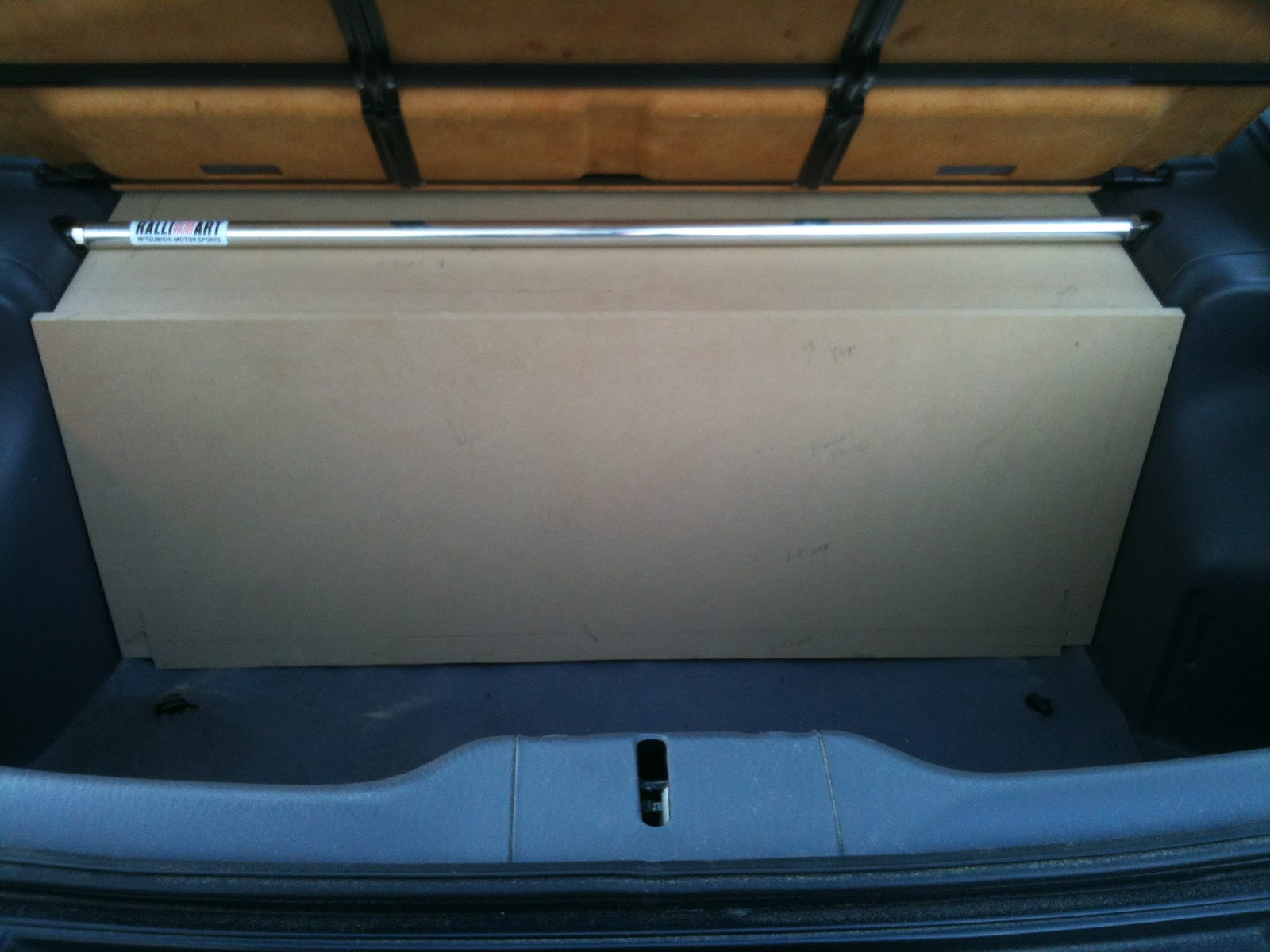After a few year of use, the original subwoofer enclosure designed for Project Eclipse began to show signs of wear and age. The original grey carpet covering shows areas of discoloration. The trim panels are also beginning to come off.
Version 1 shown below is based on a 0.7 cubic inch sealed enclosure made from 3/4 inch marine grade birch. This is a very strong and very heavy wood to use and because of the relatively small size, did not require additional bracing. The set features a rockford fosgate single voice coil P110S4 Subwoofer and a Pioneer GM3300T bridgeable power amplifier. This setup has provided more than adequate bass without being a window breaker. On a scale of 1-10, I gave this a 6 for performance / output and 3 for aesthetics.
The subwoofer enclosure is big enough to produce great sound, yet small enough so as not to take over the limited trunk space of the eclipse.
November 2011 - Wanting a little bit more bass output from the single subwoofer and at the same time increase available trunk space, Version 2 of the enclosure was constructed. This is a total redesign and the old birch box was discarded in favor of 5/8" MDF. Again, since the box is relatively small, flex is minimized even on the longest dimensions of the box and did not need a lot in internal bracing. The front baffle board was made with 2 layers of the MDF glued and nailed together.
Even though the main box area looks smaller than the birch box, the decrease in material thickness and slight adjustments in angles and measurements resulted in a box with an internal volume of a little over 0.9 cubic inch. Still originally planned as a sealed box, the possibility of doing a ported box came in. After a few more tweaks, a final box size of box 1.1 cubic inch was produced. A 3 inch pvc port was inserted on one side but provisions to plug this port were also made should the final sound produced was un-tunable. Technically, the P110S4 calls for a ported enclosure size of about 1.4 cubic inch - so 1.1 seemed a little bit too small. Fiberfill was added in the hopes of ever slightly increasing the perceived box size.
The completed box protruded less into the trunk area. A simple flat baffle board and black carpet material provided a more streamlined and minimalistic look.
As far as performance was concerned, the box was left ported since it seemed to provide a few more dB's over the sealed enclosure. It's louder inside the cabin but the sound itself felt like it was "less controlled". Speaker cone movement looked excessive but only when playing extensive bass notes at higher volumes. Sealing the box did not seem to affect the quality as much but overall output noticeably decreased. 5 for performance and 5 for aesthetics.
Box version 2 never really saw road use. Since the eclipse was basically parked for the winter, testing and playback were only done on the driveway. Fast forward a few more months to the end of Spring 2012 and the beginning of Summer 2012 and a new build was underway.
Version 3 was now in the works. The tired Rockford Fosgate P110S4 is now being retired in favor of two JL Audio 10WX-4 subwoofers. The doubling of cone area should provide more bass without increasing the box volume extensively.
The original Pioneer amplifier, despite still providing sufficient power, will not be capable of running a two ohm load. So for this duty, a corresponding JL Audio JX250/1 was chosen.
[Both subwoofers and amplifier were purchased new from a Canadian authorized JL Audio dealer. Boxing day special had the subs at $38 each and the amp at $88 - at this price, one won't even be able to purchase a crappy 6 inch tube-type subwoofer]
MDF was again chosen. The original 1.1 cubic inch box was modified to about 1.3 cubic inches. A few angled cuts, some tweaks to the shape and some more fiberfill rounded up the installation. Each speaker was given its own screw-type terminal cup. Internal speaker wiring used was 14 gauge and 8 gauge was used for power wiring. The new box was covered in a more automotive grade black carpet which should prove more resistant to everyday wear.
Version 3 resulted in a slightly bigger box (but still does not take over the small trunk area). Output was noticeably greater than the single sub and quality was better than a single sub in the ported enclosure. The new carpet looks sleeker and more professional. 7 for performance and 6 for aesthetics.
















